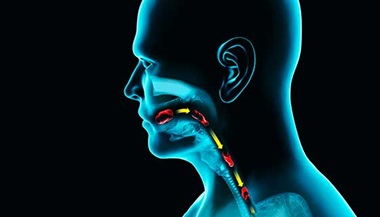Lactose Intolerance
What You Need to Know

- Lactose intolerance is an inability to digest lactose, a sugar found in milk and milk products.
- This condition often runs in families and can affect both children and adults.
- Lactose intolerance is most common in Asian Americans, African Americans, Mexican Americans and Native Americans.
- Symptoms vary from person to person, but may include: gas, diarrhea, bloating, belly pains and nausea.
- There is no treatment for lactose intolerance, but symptoms can be managed through diet changes.
What is lactose intolerance?
Lactose intolerance is when your body can't break down or digest lactose. Lactose is a sugar found in milk and milk products.
Lactose intolerance happens when your small intestine does not make enough of a digestive enzyme called lactase. Lactase breaks down the lactose in food so your body can absorb it. People who are lactose intolerant have unpleasant symptoms after eating or drinking milk or milk products. These symptoms include bloating, diarrhea, and gas.
Lactose intolerance is not the same thing as having a food allergy to milk.
Lactose intolerance is most common in Asian Americans, African Americans, Mexican Americans, and Native Americans.
What causes lactose intolerance?
Both children and adults can get lactose intolerance. Here are some common causes of this condition:
-
Lactose intolerance often runs in families (hereditary). In these cases, over time a person’s body may make less of the lactase enzyme. Symptoms may occur during the teen or adult years.
-
In some cases, the small intestine stops making lactase after an injury or after a disease or infection.
-
Some babies born too early (premature babies) may not be able to make enough lactase. This is often a short-term problem that goes away.
-
In very rare cases, some newborns can’t make any lactase from birth.
What are the symptoms of lactose intolerance?
Each person’s symptoms may vary. Symptoms often start about 30 minutes to 2 hours after you have food or drinks that have lactose.
Symptoms may include:
-
Belly (abdominal) cramps and pain.
-
Nausea.
-
Bloating.
-
Gas.
-
Diarrhea.
How severe your symptoms are will depend on how much lactose you have had. It will also depend on how much lactase your body makes.
The symptoms of lactose intolerance may look like other health problems. Always see your health care provider to be sure.
How is lactose intolerance diagnosed?
Your health care provider will talk to you about your past health and family history. They will give you a physical exam.
You may be asked not to have any milk or milk products for a short time to see if your symptoms get better.
You may also have some tests to check for lactose intolerance. These may include:
-
Hydrogen breath test. You will drink a liquid that has a lot of lactose. Your breath will be checked several times. High levels of hydrogen in your breath may mean you are lactose intolerant. This is the most common way to test.
-
Lactose tolerance test. This test checks how your digestive system absorbs lactose. You will be asked not to eat or drink anything for about 8 hours before the test. This often means not eating after midnight. For the test, you will drink a liquid that has lactose. Some blood samples will be taken over a 2-hour period. These will check your blood sugar (blood glucose) level. If your blood sugar levels don’t rise, you may be lactose intolerant.
-
Stool acidity test. This test is used for infants and young children. It checks how much acid is in the stool. If someone is not digesting lactose, their stool will have lactic acid, glucose, and other fatty acids.
Foods to Avoid if You Have IBS

How is lactose intolerance treated?
There is no treatment that can help your body make more lactase. But you can manage your symptoms by changing your diet or by using lactase supplements.
In the past, people who were lactose intolerant were told to stop taking dairy products. Today, health experts suggest you try different dairy foods and see which ones cause fewer symptoms. That way you can still get enough calcium and other important nutrients such as vitamin D.
Lactose intolerance symptoms can be unpleasant, but they won’t hurt you. So try to find dairy foods that don’t cause severe symptoms.
Here are some tips for managing lactose in your diet:
-
Start slowly. Try adding small amounts of milk or milk products and see how your body reacts.
-
Have milk and milk products with other foods. You may find you have fewer symptoms if you take milk or milk products with your meals. Try eating cheese with crackers or having milk with cereal.
-
Eat dairy products with naturally lower levels of lactose. These include hard cheeses and yogurt.
-
Look for lactose-free and lactose-reduced milk and milk products. These can be found at many food stores. They are the same as regular milk and milk products. But they have the lactase enzyme added to them.
-
Ask about lactase products. Ask your health care provider if you should take a lactase pill or lactase drops when you eat or drink milk products.
If you have trouble finding dairy products that don’t cause symptoms, talk to your provider. They can suggest other foods to be sure you get enough calcium and vitamin D. You may need to take calcium or vitamin D supplements.
Children with lactose intolerance should be seen by a health care provider for advice about what foods to eat. Dairy is an important source of calcium, protein, and vitamin D for children. The provider can help you know how to make sure your child is getting enough of these nutrients.
Living with lactose intolerance
Lactose intolerance can affect you every time you eat a snack or meal. So you need to be careful about the foods you eat every day. But many people can tolerate a certain amount of lactose and don't need to completely give it up.
It’s important to read food labels. Lactose is often added to some boxed, canned, frozen, and prepared foods such as:
-
Bread.
-
Cereal.
-
Lunch meats.
-
Salad dressings.
-
Cake and cookie mixes.
-
Coffee creamers.
Check food labels for words that may mean a food has lactose in it, such as:
-
Butter.
-
Cheese.
-
Cream.
-
Dried milk.
-
Milk solids.
-
Powdered milk.
-
Whey.
When should I call my health care provider?
Call your health care provider if you have trouble managing your symptoms. Some symptoms can be embarrassing. Your provider can work with you to help keep them under control.




